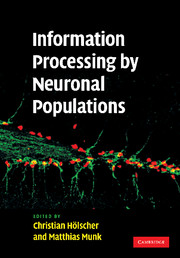Book contents
- Frontmatter
- Contents
- List of contributors
- Part I Introduction
- Part II Organization of neuronal activity in neuronal populations
- 2 Cellular mechanisms underlying network synchrony in the medial temporal lobe
- 3 Cell assemblies and serial computation in neural circuits
- 4 Neural population recording in behaving animals: constituents of a neural code for behavioral decisions
- 5 Measuring distributed properties of neural representations beyond the decoding of local variables: implications for cognition
- 6 Single-neuron and ensemble contributions to decoding simultaneously recorded spike trains
- Part III Neuronal population information coding and plasticity in specific brain areas
- Part IV Functional integration of different brain areas in information processing and plasticity
- Part V Disturbances of population activity as the basis of schizophrenia
- Part VI Summary, conclusion, and future targets
- Index
- References
3 - Cell assemblies and serial computation in neural circuits
Published online by Cambridge University Press: 14 August 2009
- Frontmatter
- Contents
- List of contributors
- Part I Introduction
- Part II Organization of neuronal activity in neuronal populations
- 2 Cellular mechanisms underlying network synchrony in the medial temporal lobe
- 3 Cell assemblies and serial computation in neural circuits
- 4 Neural population recording in behaving animals: constituents of a neural code for behavioral decisions
- 5 Measuring distributed properties of neural representations beyond the decoding of local variables: implications for cognition
- 6 Single-neuron and ensemble contributions to decoding simultaneously recorded spike trains
- Part III Neuronal population information coding and plasticity in specific brain areas
- Part IV Functional integration of different brain areas in information processing and plasticity
- Part V Disturbances of population activity as the basis of schizophrenia
- Part VI Summary, conclusion, and future targets
- Index
- References
Summary
Introduction
Analogies between the brain and the digital computer have been out of fashion for a long time. The differences between brains and computers are numerous. Computers run pre-specified programs written by people. Computers store programs and data in specialized RAM circuits, and have one CPU (or at most a handful) which follows a coded list of instructions to the letter. A computer has a central clock, which allows all of its components to march through a program in lockstep. The brain, on the other hand, has billions of neurons operating in parallel, no central clock, no externally supplied list of instructions, and no separation of RAM and CPU. Although the inventors of the modern computer held the brain as a model, the analogy is rarely taken seriously today.
A more popular analogy for the brain in recent years has been artificial neural networks (ANNs). ANNs, although typically simulated on a digital computer, have an apparently more “brain-like” design. They consist of elements that function (at least a bit) like neurons, connected by “synapses” whose strength can be modified by the network's history. ANNs do not need an external program, but “learn” from a set of training examples. The most successful of these, the multilayer perceptron or “backprop” net, is good enough at generalizing from training examples to be used in real-world information processing tasks, by people who have no interest in how the brain works.
- Type
- Chapter
- Information
- Information Processing by Neuronal Populations , pp. 49 - 73Publisher: Cambridge University PressPrint publication year: 2008

